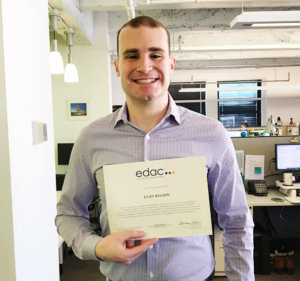As a leader in lighting design, The Lighting Practice works with some of the brightest and most proficient designers in the country. Providing cutting-edge lighting design solutions is a testament to the team’s commitment to continued learning and understanding our clients’ needs. Recently, Evan Wilson obtained his Evidence-Based Design Accreditation and Certification (EDAC) from The Center for Health Design. This certification helps enable TLP to improve outcomes in healthcare facilities and advance the study of lighting’s positive impact on patient stress, staff effectiveness, safety, and quality of care in these environments.
The Center for Health Design describes evidence-based design (EBD) as “the process of basing decisions about the built environment on credible research to achieve the best possible outcomes.” Designers utilize the eight steps of the EBD process to find research-based solutions that are likely to achieve their client’s goals.
“The architecture, engineering, and construction (AEC) industry is starting to see a shift in trends related to applied research and the built environment,” Evan said. “Historically, this research has occurred within the realm of academia. Today, we are increasingly tasked with incorporating research into our design, so we must evaluate the effectiveness of our strategies and their implications and on a larger scale. Cutting-edge research is no longer just happening in the light lab; it’s also happening on the job site.”
The EDAC program gives industry professionals the opportunity to be proficient in the evidence-based design process. The exam tests participants on their understanding in five key areas: healthcare, research, pre-design, construction, and occupancy. Upon passing the exam, certified individuals maintain their status by completing six hours of approved continuing education units in evidence-based design every two years.
“It is important for us as design consultants to be well versed in the manners and methods of applied research so that we can deliver fresh, innovative solutions to our clients and reliably contribute to the body of knowledge on human-centric design strategies,” Evan said.
Evan joined The Lighting Practice in 2017. He started his career in entertainment and then transitioned to architecture while working for a Philadelphia lighting firm. While earning his master’s degree, Evan gained experience on the research side of the industry in topics that include human factors and circadian stimulus, optics design and modeling, industry applications for 3D printing, and the development of metrics for backlit signage. As a designer with The Lighting Practice, Evan’s project experience includes corporate, healthcare, hospitality, multi-family residential, places of worship, retail, and transportation.
“One of the things that excites me most about lighting design is being able to sit at the forefront of an ever-expanding knowledge base of lighting,” Evan said. “The EDAC credential gives us the tools and the authority to help write the next chapter.”






